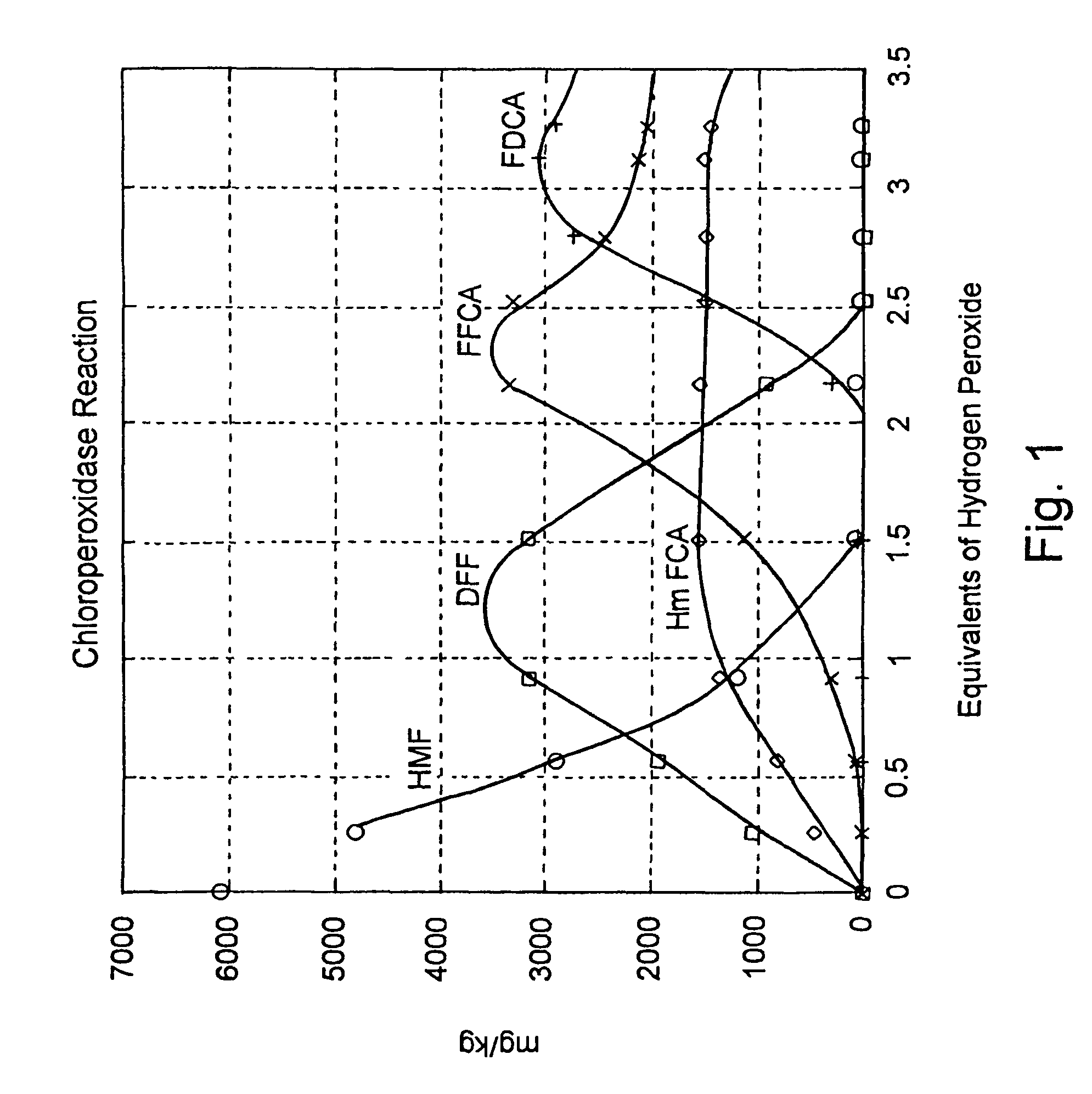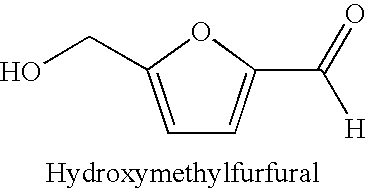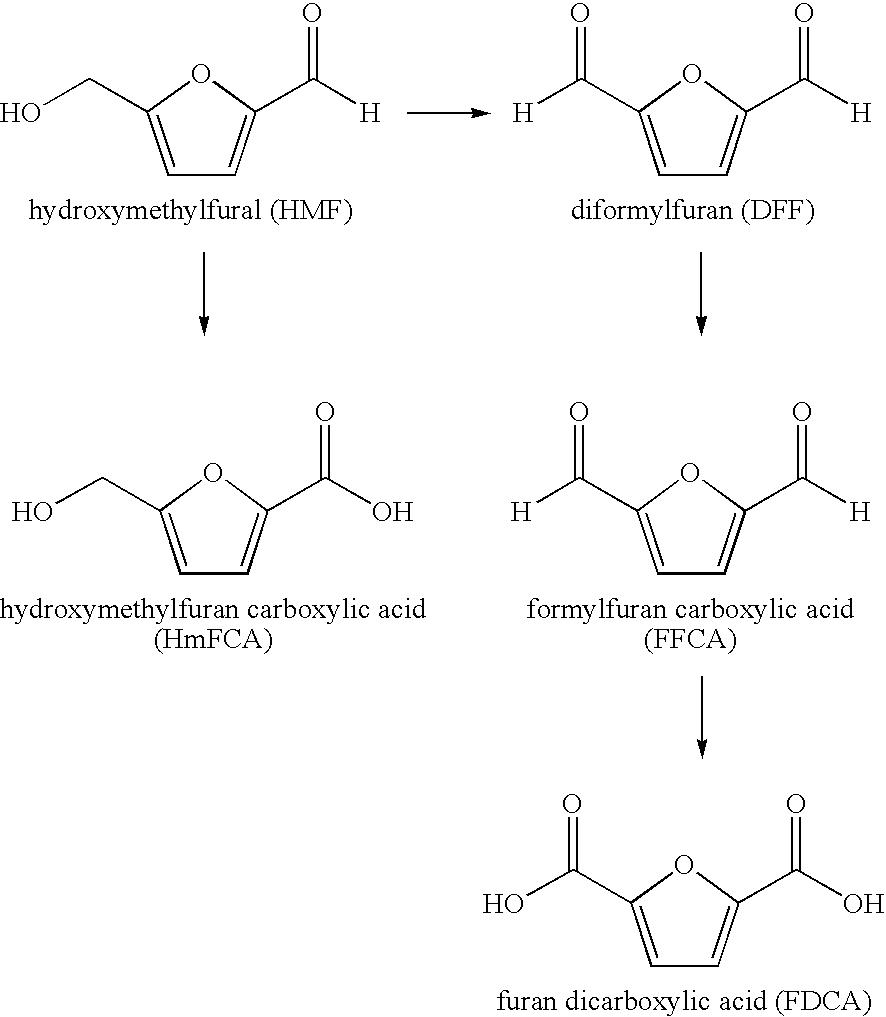Enzymatic oxidation of hydroxymethylfurfural
a technology of hydroxymethylfurfural and hydroxymethylfurfurfural, which is applied in the field of oxidizing hydroxymethylfurfural, can solve the problems of difficult and expensive purification steps of reaction mixtures, limited conversion of alcohol of polysaccharides to aldehydes, and difficult in practice to convert hmf into one specific oxidation produ
- Summary
- Abstract
- Description
- Claims
- Application Information
AI Technical Summary
Benefits of technology
Problems solved by technology
Method used
Image
Examples
example 1a
Screening Oxidases for Oxidation of HMF
[0041]Nine different Aryl-alcohol oxidases (AAO) were obtained from Biocatalytics Inc, (a.k.a Codexis Inc, Pasedena, Calif.). They were labeled AAO-101 thru AAO-109. 12.6 mg of HMF was dissolved in two ml of buffer supplied by Biocatalytics Inc. (50 mM KPO4, 10 mg / l catalase, pH 7.0—the catalase was Fermcolase™ (Danisco US Inc., Genencor Division, Rochester, N.Y.) and combined with approximately 16-20 mg of each of the nine different AAO's in a 15 ml closed tube and rotated on a tube rotator. Time points were taken at 5, 24, and 72 hr. After 72 hr all nine AAO's converted some of the HMF to DFF. AAO-109 was the worst converting only about 3% of the HMF to DFF after 72 hr. AAO-101, AAO-102, AAO-103, AAO-105, AAO-106, AAO-107, and AAO-108 made between 70% and essentially 100% DFF in 5 hr. AAO-104 was able to convert approximately 60% of the HMF to DFF in 72 hr. AAO-108 was able to further oxidize the DFF to FFCA converting about 60% of the origin...
example 1b
Aryl Alcohol Oxidase Oxidation of HMF to DFF
[0045]50 mg Aryl-alcohol oxidase (Biocatalytics Inc., Cat. # AAO-101, lot # 1092403MM) was combined with 30 mg hydroxymethylfurfural in aqueous solution (Aldrich Chemical Co.), 100 μL fermcolase (Genencor), 0.5 ml 0.5 M KHPO4 buffer and 4.5 mL water in a 15 mL falcon reaction tube. The reaction tube was then rotated at slow speed on a tube rotator (Barnsted / Thermolyne Labquake Model # 415110). Samples taken at 0, 2 and 24 hours were spotted on TLC plates (K5F Whatman) and developed in 85:15:2 acetonitrile:water:glacial acetic acid and visualized under UV light. Visual Analysis indicates that after 2 hours, approximately 80% of the HMF was converted to DFF. After 24 hours, substantially all of the HMF was converted to DFF.
example 2
Aryl Alcohol Oxidase Oxidation of HMF to DFF and Other Oxidized Derivatives
[0046]12.64 mg hydroxymethylfurfural (Aldrich Chemical Co.) was combined with 16.7 mg Aryl-alcohol oxidase (Biocatalytics Inc.) and 33 μL catalase (Biocatalytics Inc.) in a 15 mL falcon tube and aerated as in Example 1. Samples were taken at 0, 5, 24 and 72 hours and analyzed by LCMS.
[0047]
HMFDFFFFCAFDCATime(mg / kg)(mg / kg)(mg / kg)(mg / kg) 5 hrs9.685939.2339.460.1024 hrs15353102072037861151
[0048]As is shown, after 5 hrs, the reaction mixture contained 9.68 mg / kg HMF (0.15%), 5940 mg / kg DFF (94.0%), 39 mg / kg FFCA (0.62%). Thus, after 5 hours, the conversion of HMF to DFF is essentially complete, even without the use of catalase. However, as the results show, the DFF is further converted to other products when no catalase is present in the reaction mixture.
PUM
| Property | Measurement | Unit |
|---|---|---|
| temperature | aaaaa | aaaaa |
| temperature | aaaaa | aaaaa |
| temperature | aaaaa | aaaaa |
Abstract
Description
Claims
Application Information
 Login to View More
Login to View More - R&D
- Intellectual Property
- Life Sciences
- Materials
- Tech Scout
- Unparalleled Data Quality
- Higher Quality Content
- 60% Fewer Hallucinations
Browse by: Latest US Patents, China's latest patents, Technical Efficacy Thesaurus, Application Domain, Technology Topic, Popular Technical Reports.
© 2025 PatSnap. All rights reserved.Legal|Privacy policy|Modern Slavery Act Transparency Statement|Sitemap|About US| Contact US: help@patsnap.com



